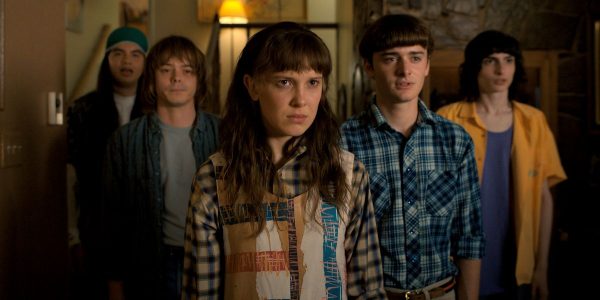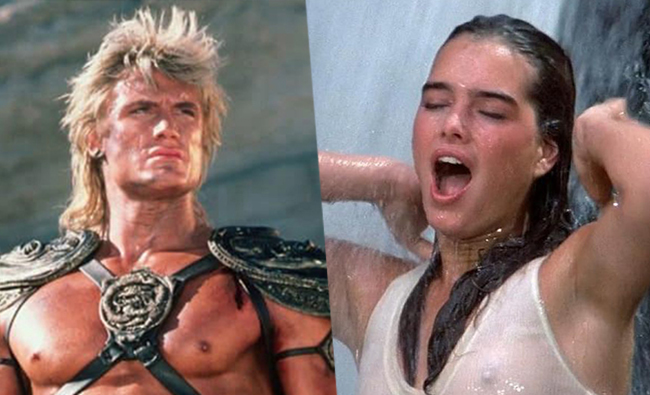Shaun Munro reviews Stranger Things season 4 volume 1…
The belated fourth season of Netflix’s Stranger Things – arriving almost three years after the third, in part due to extensive COVID-related production delays – is a messy, fascinating beast. It’s a testament to both the expansive, large-scope storytelling and creator self-indulgence made possible when those in charge seemingly let showrunners do whatever they want.
The fact that the sci-fi horror series’ new batch of episodes reportedly cost a princely $30 million a pop – the average budget of a modestly mid-scale genre film – reflects the prestigious regard the recently embattled streamer holds the show in.
And boldly, this new seven-episode volume of stories – with the two remaining episodes set to drop in early July – takes some sharp left turns from the show’s established formula, daring to splinter the ensemble off into some majorly disparate narrative pockets, while leaning further into grim horror territory than ever before.
Taking place mere months after season three – a fact rendered regularly comical by the noticeably aged cast – season four picks up with Eleven (Millie Bobby Brown) attempting to restart her life in the sun-kissed California town of Lenora Hills, fending off bullies albeit without the supernatural abilities she lost the last time we saw her.
Back in Hawkins, Indiana, the gang has to contend with the emergence of a new supernatural threat – a horrifying humanoid creature by the name of Vecna, which rampages throughout Hawkins feeding off the fear and anxiety of troubled teens, before killing them in bone-breaking, eye-gouging fashion.
Elsewhere Hopper (David Harbour) is imprisoned in a Soviet gulag following his sacrifice at the end of season three, and it falls to Joyce (Winona Ryder) and Murray Bauman (Brett Gelman) to try and find a way to rescue him.
On paper this provides plenty of propulsive narrative fuel for seven episodes of TV, and yet, the prevailing feeling walking away is that the Duffer Brothers ended up stretching themselves and their cast way too thin.
With all-but-one of the episodes exceeding 70 minutes – the finale to volume 1, in fact, clocks in at a movie-length 98 minutes – there comes the expectation that the show is seriously upping its scale and stakes as it enters the final phase of its overall narrative arc.
And yet, there’s a pervasive feeling of bloat permeating through the seven episodes, that the Duffers never seemed to find a keen dramatic focus point for the series, instead listlessly cutting from one plot to another in higgledy-piggledy fashion.
It doesn’t help that there’s such a blatant inconsistency between the main narrative strands; the Hawkins monster plot and Eleven’s personal odyssey are clearly the strongest stories, while Hopper’s imprisonment is a distended and repetitive jaunt that runs out of steam long before it finally reaches a resolution. Joyce is also disappointingly relegated to card-carrying backseat duty this time around in her quest to free Hopper.
But at a broader level it’s simply just disappointing to see the cast carved up into such isolated plots that deny the potential for cross-pollination, what with each being situated thousands of miles from the others. There’s a distinct feeling of the pudding being over-egged given the number of mainstay characters whose roles feel close to nothing by season’s end – especially Byers brothers Will (Noah Schnapp) and Jonathan (Charlie Heaton).
The struggle to juggle literally dozens of characters at this point is palpably felt, unaided by the addition of numerous significant new characters, such as sardonic, cynical D&D metalhead Eddie (Joseph Quinn), who is admittedly guaranteed to become an immediate fan favourite.
Even with such a sizable canvas, so many characters feel under-served by this story, which in its ambition forgets the most basic fundamental that made the show a hit in the first place; the charm of seeing these youngsters together, investigating creepy shit in their town.
But Stranger Things can’t of course tell the same story forever, and it’s simply realistic that youngsters do indeed move on from their friends eventually, even if the Duffers can’t find a way to reconcile this satisfactorily.
Yet as negative an assessment as this all might sound, season four is certainly the most narratively and tonally adventurous batch of episodes to date, showing off the Duffers’ clear love for classic horror. The central threat is blatantly similar to the dreamfaring terror of A Nightmare on Elm Street’s Freddy Krueger, and in a further cute nod to that, Krueger actor Robert Englund also cameos in one episode as a plot-pivotal character.
Elsewhere the Stephen King-isms are cranked up to 11 in ways sure to give his many fans more than a few smirks, but rather than rest on mere homage and nostalgia-baiting – as has been one of the show’s most fair persistent criticisms – season four dares to establish a genuinely unsettling horror vibe of its own.
Without going into too much detail, the series has never been more unnerving or grotesque than it is here; body horror is a regular invocation throughout these seven episodes in ways both genuinely brutal and totally unexpected. It also taps into some more under-explored concerns of its era, such as the infamous Satanic panic of the ’80s, whereby the media perpetuated the myth that Satanism was attempting to subvert the United States and corrupt the nation’s youth.
Since its inception, Stranger Things has felt a bit like pizza in TV form; it never manages to drop below a baseline level of enjoyment in even its lousiest form – that is, season two’s infamous backdoor pilot episode – and to that end, even season four’s sloppy missteps can’t entirely undermine the outstanding production quality and superb efforts of the cast.
The visual effects throughout certainly feel worthy of the movie budgets each episode commands, and the directing triumvirate of the Duffers, Shawn Levy (Free Guy), and Nimród Antal bring a real stylistic heft to the fore. This is best evidenced by a thrilling mid-season escape sequence set to a certain beloved pop banger, and a brief-but-thrilling single-take shootout.
The cast also hasn’t missed a step, the easy standouts being Millie Bobby Brown (as usual) as Eleven, Sadie Sink as the beleaguered Max, and Maya Hawke as last season’s instant fan fave Robin. But there’s not a weak link among the set, and all of the new additions – including not only Joseph Quinn’s Eddie but also Jonathan’s new Cali stoner buddy Argyle (Eduardo Franco) – slot effortlessly into the collective.
All in all Stranger Things’ fourth season doesn’t go down as smoothly as its earlier entries, yet respectably attempts to do something different, even as it gets bogged down in major narrative bloat. Temper your expectations and there’s plenty to enjoy here, albeit while decidedly more uneven than ever before.
Shaun Munro – Follow me on Twitter for more TV rambling.
















